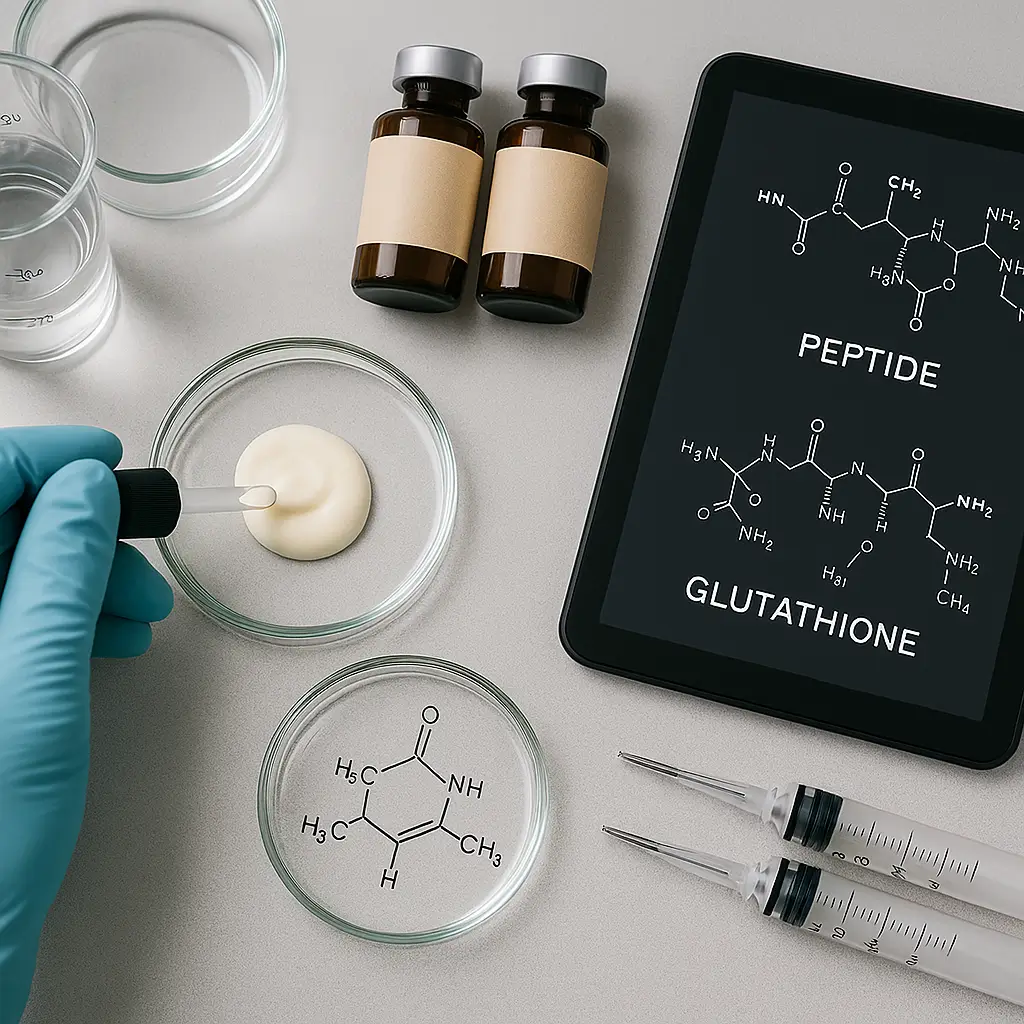The science of emulsion formulation continues to advance, especially within the domain of topical antioxidant research. In laboratory settings, researchers frequently develop prototype moisturizers to study the interaction and stability of bioactive ingredients under various conditions. Glutathione, a tripeptide antioxidant, and peptides, renowned for their multifunctional roles, are at the forefront of such studies. Understanding how these compounds behave in a moisturizer matrix—both individually and synergistically—offers invaluable insights for the advancement of cosmetic science, biochemistry, and delivery systems research.
Glutathione in Laboratory Moisturizer Formulation
Scientific Rationale
Glutathione (GSH) is one of the most researched antioxidants in biochemistry due to its critical role in cellular defense against oxidative stress. In research on topical delivery, glutathione is chosen to:
- Model antioxidant release and degradation in emulsion systems
- Investigate interactions with other antioxidants and stabilizers
- Examine matrix stability and protection against environmental stressors
Laboratory formulations provide a controlled setting for examining glutathione’s fate and function—free from the complexities of in vivo metabolism.
Forms of Glutathione for Research
- Reduced Glutathione (GSH): Primary antioxidant, highly sensitive to oxidation.
- Oxidized Glutathione (GSSG): Used for studying redox cycling.
- Encapsulated Glutathione: Sometimes deployed in advanced delivery studies.
For all experiments, research-grade purity is mandatory to minimize variables.
Peptides: Versatile Tools for Advanced Moisturizer Studies
Peptide Science in Formulation Research
Peptides are short amino acid chains with broad utility in topical research. Laboratory investigations often include peptides to:
- Study their stabilizing effects within emulsions
- Assess synergy with antioxidants like glutathione
- Evaluate their controlled release and degradation under various conditions
Popular peptides for research include palmitoyl tripeptide-1, palmitoyl tetrapeptide-7, copper peptides, and custom synthetic sequences designed for analytical purposes.
Why Combine Glutathione and Peptides?
Combining glutathione and peptides in one matrix allows researchers to explore:
- Potential stabilization of antioxidants by peptides
- Mutual effects on degradation and release kinetics
- New analytical models for multi-active systems
Such dual-active systems model real-world complexity, providing a robust platform for advanced scientific inquiry.
For researchers seeking advanced materials for laboratory experiments, a wide range of Peptides for Sale can be found through specialized scientific suppliers, supporting ongoing innovation in formulation science.
Base Ingredients and Their Research Functions
1. Aqueous Phase
- Deionized Water: Essential for consistency and to prevent unwanted reactions.
- Humectants: Glycerin, hyaluronic acid, and propylene glycol function as water retainers, enhancing the study of hydration in emulsions and acting as solvents for glutathione and peptides.
- Buffering Agents: Used to maintain optimal pH, essential for glutathione and peptide stability.
2. Oil Phase
- Emollients: Squalane, caprylic/capric triglycerides, or mineral oil. These are chosen for their inertness, non-reactivity, and clarity in analytical testing.
- Fatty Alcohols: Cetyl or stearyl alcohol provide thickening, stabilization, and secondary emollient effects.
3. Emulsifiers
- Polysorbate 60/80: Critical for oil-in-water emulsion stability; enables even distribution of actives.
- Cetearyl Alcohol & Ceteareth-20: Often used in tandem for reliable emulsification and smooth texture.
4. Stabilizers & Preservatives
- Antioxidants: Vitamin E acetate, ascorbyl palmitate, and sometimes peptides with antioxidant effects help protect the active matrix.
- Chelators: EDTA or similar binders sequester metal ions that may otherwise catalyze degradation.
- Preservatives: Phenoxyethanol, ethylhexylglycerin, or research-approved parabens are used to prevent microbial contamination during storage and testing.
Detailed Laboratory Formulation Protocol
Step 1: Preparation of Phases
Aqueous Phase:
- Dissolve humectants, buffering agents, peptides, and glutathione in deionized water.
- Maintain temperature below 40°C throughout, as both peptides and glutathione are heat-sensitive.
Oil Phase:
- Combine emollients, fatty alcohols, and emulsifiers.
- Gently heat (65–70°C) until the mixture is uniform.
Step 2: Emulsification
- Add oil phase to aqueous phase gradually while using a high-shear homogenizer. Proper shear is key to forming a stable, small-droplet emulsion.
- Closely monitor temperature and mixing speed to prevent denaturation of glutathione and peptides.
Step 3: Cooling and Heat-Sensitive Additions
- Continue mixing as the emulsion cools.
- Add glutathione, sensitive peptides, antioxidants, and preservatives once the emulsion falls below 40°C.
Step 4: pH Adjustment and Finalization
- Adjust pH to 5.0–6.5. Both glutathione and most peptides exhibit greatest stability in this range.
- Add any remaining chelators or stabilizers.
- Ensure uniformity, then transfer to sterile research-grade containers.
Analytical Evaluation in Laboratory Studies
Stability Testing
- Chemical Stability: Use HPLC, LC-MS, or UV-Vis to monitor glutathione and peptide content over time.
- Physical Stability: Observe for phase separation, droplet size changes, or viscosity shifts under temperature cycling and accelerated aging.
Release and Permeation Testing
- Franz Diffusion Cell Assays: Measure release kinetics of glutathione and peptides across synthetic membranes.
- In Vitro Model Membranes: Evaluate permeation potential, relevant for delivery research.
Synergy and Interaction Studies
- Antioxidant Synergy: DPPH, ORAC, or ABTS assays determine if peptides and glutathione have additive or synergistic antioxidant effects.
- Matrix Interaction: Monitor aggregation, precipitation, or incompatibility between actives and excipients.
Advanced Formulation Approaches
- Encapsulation: Liposomes, niosomes, or nanoemulsions may be employed to enhance active stability and enable targeted release studies.
- Layered Emulsion Systems: Create multi-phase systems for stepwise release of glutathione and peptides.
Troubleshooting and Optimization Tips for Researchers
- Ingredient Compatibility: Conduct preformulation tests to ensure glutathione and peptides remain stable and non-reactive with other excipients.
- Temperature Sensitivity: Keep formulation and storage temperatures below 40°C to preserve active structure.
- Oxidation Protection: Include multiple antioxidants or inert atmosphere packaging if oxidative degradation is problematic.
- Microbial Stability: Always use appropriate preservatives; verify by microbial challenge testing as per laboratory SOP.
Expanding the Research Scope
Modern laboratory research does not stop at stability and release. Other avenues of investigation include:
- Photostability Studies: Expose formulations to controlled light to measure degradation.
- Shear and Mechanical Stress: Study how processing affects matrix integrity.
- pH Cycling: Simulate environmental changes to predict long-term stability.
For access to protocols, research literature, and lab-grade ingredients, researchers can consult eromey.com, a valuable hub for formulation science.
Conclusion
The formulation of a glutathione- and peptide-infused moisturizer for laboratory study offers a dynamic model for investigating antioxidant stability, emulsion science, and ingredient interactions. With meticulous ingredient selection, rigorous technique, and robust analytical protocols, researchers can generate data that underpin innovation in topical delivery and cosmetic science—always within the boundaries of non-biological, controlled laboratory research.
By integrating comprehensive scientific methods and leveraging resources, laboratories can push the envelope in formulation studies, all while maintaining ethical, legal, and scientific rigor. The possibilities for new insights into emulsion stability, active synergy, and advanced delivery science are vast—ensuring this field remains a rich ground for ongoing laboratory discovery.

